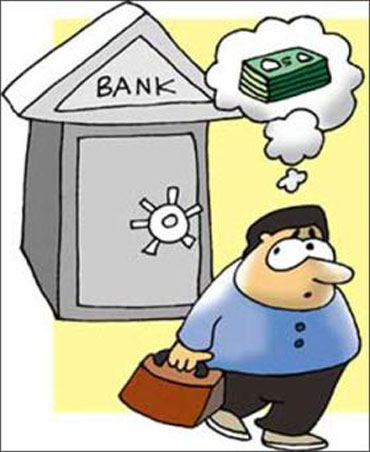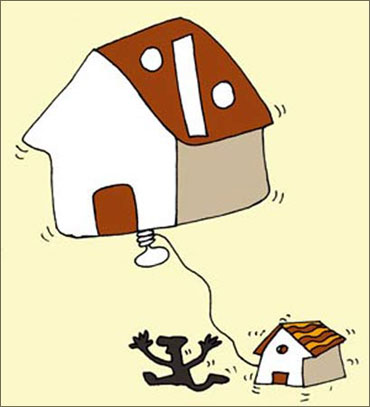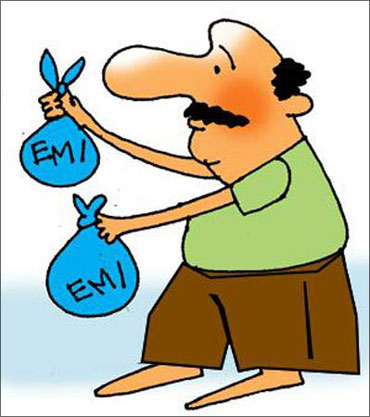Tinesh Bhasin and Neha Pandey in Mumbai
Floating rate home loan borrowers, stuck on higher interest rates, can expect some relief from today (July 1).
The introduction of base rate will ensure that if they are linked to it, they will see automatic rise and fall in their existing rates.
And here's more good news: The Reserve Bank of India has asked banks not to charge any fee for shifting from prime lending rate to base rate.
Importantly, even though banks are going to charge a fee -- in excess of 1.5 per cent in most cases -- for renegotiating the loan, it could still make sense in doing so.
Once you have shifted to the latest rate, this along with the linkage with base rate will ensure that future costs are saved.
"The PLR regime was stickier. Banks took a longer time to align PLR with the interest rate movements," KVS Manian, head, retail banking, Kotak Mahindra Bank.
However, only home loan rates will be impacted by this. All other retail loans, like auto and personal, are given at fixed interest rate.
So what is base rate? Click NEXT to find out. . .
What is base rate? How does it affect home loan borrowers?
What is base rate?
From July 1, banks will move to a new, more transparent regime of loan pricing. They will jettison the Benchmark Prime Lending Rate (BPLR) and price loans off a 'base rate'.
Unlike the BPLR that was set somewhat arbitrarily by banks, the base rate will follow an explicit formula that factors in a bank's cost of deposits, operating costs (expenses of running its branches, for instance), the cost of statutory drafts on bank funds imposed by the Reserve Bank of India (the Cash Reserve Ratio and Statutory Liquidity Ratio) and the profit margin.
The base rate will help borrowers to compare interest rates offered by various banks and make the process of how banks arrive at interest rates for loans more transparent.
RBI has stipulated that banks cannot charge below the base rate for most loans. (There are a couple of exceptions like agricultural loans and export credit.) While the new model will ensure greater transparency, it need not mean lower lending rates for borrowers.
In fact, banks' blue-chip corporate borrowers could see some increase in their cost of borrowing. The reason is somewhat simple. RBI allowed banks to lend below their prime lending rates and the majority of banks did the bulk of their corporate lending at 'sub-PLR rates'.
The new reference rate for country's largest bank is 7.5 per cent. Most of the other public sector banks have the base rate at 8 per cent. These include, IDBI Bank, Indian Bank, Bank of Baroda, Allahabad Bank and Punjab National bank. HDFC Bank has set the rate at 7.25 per cent.
The best 'credits' for a bank could drive the hardest bargains. This led to peculiar situations in which a bank whose official BPLR was in the range of 14-16 per cent was found lending to its best customers way below its costs at 5-6 per cent.
The incentive for this 'irrational' pricing was to keep the ratio of non-performing assets low, particularly in the wake of the global financial crisis when banks' risk appetite waned and safety got precedence over margins. The base rate regime does away with this.
So how will it affect home loan borrowers? Click NEXT to find out. . .
What is base rate? How does it affect home loan borrowers?
Not all home loan customers will benefit
But not all home loan customers would benefit linking their loans to the new benchmarking system. For example, if you have taken a teaser loan just few months back, it would still make sense to stick to it.
And with SBI planning to continue its teaser rate of 8 per cent for the next three months, borrowers would continue to benefit.
"In dual rate (or teaser) loans, a borrower gets fixed rates for the initial years. This means, there is predictability of monthly outgo for this period and the borrower, in turn can plan his finance accordingly without bothering about interest rate fluctuation," said a certified financial planner.
For an existing borrower, there are some situations in which they will benefit by shifting. In other cases, it may not make much difference.
Less than one year: If you have taken the loan just a year back, around 90 per cent of the equated monthly instalment (EMI) goes towards repayment of interest and the rest towards principle.
If serving a floating rate loan for less than two years, financial planner said it makes sense to shift the loan - even if the lender is charging you an interest of 9-9.5 per cent.
When a person shifts to base rate, the interest is likely to remain the same. In addition, shifting is free. Shifting early to the new benchmark would only help to get the benefits earlier. And if the existing loan rate is around 1-2 per cent lower than your existing rate, it makes sense to renegotiate as well.
Of course, there will be a charge. But you can easily get into a new regime which is completely new and more sensitive to changes.
. . .
What is base rate? How does it affect home loan borrowers?
2 to 5 years: There is a strong possibility that such borrowers are stuck at higher floating rates of 12-13 per cent. It certainly makes sense for them to shift from their existing rates to new ones. And by paying the renegotiating charges as well.
Other customers should shift to the base rate as even in the fifth year, the interest portion is as over 40 per cent if the tenure is 15 years and more for loans with longer tenure.
There are customers who fixed their loan rate at 7.5-8 per cent in 2003-04 period, it makes less sense for them to shift. Especially, if their loan rate is fixed for the entire tenure.
5 to 10 years: This is a crucial period to decide whether to shift or not. For a 15-year loan, two-third of the loan is repaid. For 20-year loan, the interest portion in the tenth year is still more than principle.
"There are chances that a person has brought the tenure further down by prepaying a portion of the loan as and when possible," said a certified financial planner. A person can stick to the BPLR who has 15-year tenure. For loans over 15 years, base rate would make sense as there are still many years left to service the loan.
. . .
What is base rate? How does it affect home loan borrowers?
Over 10 years: If your loan tenure is of 20 years, almost 50 per cent of the time period is remaining. But the good part is that most of the interest payout has taken place.
During these years, the principle portion in the EMI accounts for 60 per cent or more, as you get closer to repaying the loan. Shifting to base rate is a tough call in such a situation.
Do your math and compare the advantages of BPLR vis-a-vis base rate. If you have more than three years to repay the loan and you still saving money on the EMI, go for it.
What you must do: Shift to base rate anyway. Because it will ensure that you get the advantage of loan rate fluctuations.
As far as renegotiations go, it would be a decision based on the tenure that is remaining, and your finances.
But how will banks gain? Click NEXT to find out. . .
What is base rate? How does it affect home loan borrowers?
If the blue-chips stand to lose in the new regime, who stands to gain? Some would argue that banks 'subsidised' the low-cost loans to their prime borrowers by charging hefty rates from smaller, riskier borrowers -- small and medium enterprises and households, for example.
Those who argue this claim that once banks are forced to price loans in line with their costs, these 'subsidies' are likely to disappear and the segments that arguably need the money the most are likely to get fairer rates.
The other thing that the base rate could prevent to a degree is what regulators term 'predation' -- the phenomenon of large banks dropping loan rates way below costs to grab market share.
There have been recent instances of predation in retail credit markets breeding the risk of credit bubbles building up on the back of these exceptionally cheap loans.
From a monetary policy perspective, a transparent basis for credit pricing should make the transmission of policy impulses to actual lending rates more efficient.
It would at least provide a better gauge of whether monetary policy changes are making a difference to borrowing and lending rates on the ground. There is a case to be made for some structural changes in the policy rates as well.
As the current liquidity crunch in the banking system has shown, the wide gap of one-and-half percentage points between the reverse repo and the repo rates drives large swings in short-term interest rates as the banking system goes from surplus to deficit and vice versa.
This volatility is perhaps undesirable and can be ironed out by reducing this gap. A hike in the reverse repo rate, keeping the repo rate unchanged in the RBI's July 27 Monetary Policy could do the trick.








article